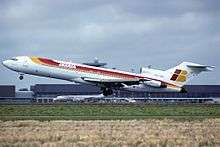Iberia Airlines Flight 610
Iberia Airlines Flight 610 was a scheduled domestic passenger flight from Madrid to Bilbao, Spain. On 19 February 1985, a Boeing 727-200 operating the flight crashed into a television antenna on the summit of Mount Oiz in Biscay near Bilbao. All 141 passengers and 7 crew on board died.[1] The crash is the deadliest aviation disaster in both Basque Country and Iberia history.
 An Iberia Boeing 727-200 similar to the one involved | |
| Accident | |
|---|---|
| Date | 19 February 1985 |
| Summary | Controlled flight into terrain due to pilot error |
| Site | Mount Oiz, Biscay, Spain 43°13′43″N 02°35′24″W |
| Aircraft | |
| Aircraft type | Boeing 727–256 |
| Aircraft name | Alhambra de Granada |
| Operator | Iberia |
| Registration | EC-DDU |
| Flight origin | Madrid–Barajas Airport, Spain |
| Destination | Bilbao Airport, Spain |
| Occupants | 148 |
| Passengers | 141 |
| Crew | 7 |
| Fatalities | 148 |
| Survivors | 0 |
Aircraft
The aircraft involved was a Boeing 727–256, powered by three Pratt & Whitney JT8D-9A turbofan engines capable of carrying 189 passengers and registered as EC-DDU. The aircraft was named Alhambra de Granada. It entered service on 18 May 1979 and had flown 13,408 hours at the time of the accident.
Flight
Flight 610 departed Madrid–Barajas Airport at 08:47 CET and was scheduled to land at Bilbao Airport at 09:35.
While on a standard approach into Bilbao at 4,300 feet (1,300 m), the crew switched on the altitude alert system whilst flying through overcast and rainy weather. At 09:09 the crew received permission to descend to flight level 4,300 feet (1,300 m), and at 09:16 the first officer established contact with the tower of Bilbao airport. Then the controller gave permission to continue the descent: "Iberia 610, you can continue descent, for an ILS approach to Bilbao, runway 30, wind is 100 degrees [at] 3 knots, QNH 1025 and transition level 70 [6,998 feet (2,133 m)]". The crew repeated the transmitted information, after which the controller offered them a direct approach. However, the captain refused, choosing a standard approach plan. At 09:22 the crew reported on the VOR passage of Bilbao at an altitude of 7,000 feet (2,100 m), reaching the starting point of the landing approach. The crew received permission to descend to an altitude of 5,000 feet (1,500 m). This was the last radio transmission from Flight 610.
The aircraft reached 5,000 feet (1,500 m) at 09:25. The minimum height in the region was 4,354 feet (1,327 m), but the crew set the altitude on the warning system to 4,300 feet (1,300 m). However, after reaching this altitude the plane continued descending. The weather conditions at that time were cloudy with fog, with 2.5 miles (4.0 km) of visibility. The descent was controlled by the autopilot. The altitude alert went off when the plane reached 4,040 feet (1,230 m); the captain interpreted this to be the approach alert mode alarm and ignored it and continued the descent. At 09:27, after 57 seconds from the moment of descent to a safe altitude and 19 miles (31 km), flying 177 feet (54 m) above Mount Oiz (elevation 3,356 feet (1,023 m)) in a landing configuration (with flaps extended and landing gear lowered), and at a speed of 385 kilometres per hour (239 mph), the aircraft collided with an TV antenna of the Euskal Telebistarues television tower at 3,356 feet (1,023 m), shearing off its left wing. The aircraft then fell 2,130 feet (650 m) from the TV tower and crashed into a forest. All 148 people on board died.[2][3]
Cause
According to the investigation, the crew distrusted the autopilot during the descent phase, but it is likely that they forgot to turn on the ALT SEL (altitude select) button, accidentally disengaged it, or the system itself malfunctioned. As a result, after reaching their assigned altitude, the autopilot did not support it, which led to a further decline, and the pilots did not control it. When the altitude alert sounded, the crew most probably misinterpreted the alarm. Investigators also discovered that the TV tower installed on the mountain was not marked on the navigation maps available to the crew.[3]
Investigators determined the cause of the crash was pilot error due to the flight crew misinterpreting data and flying the aircraft below the safety altitude. The accident report stated:
"Their [i.e. the pilots'] confidence on the automatic capture performed by the Altitude Alert System, the misinterpretation of its warnings, as well as a probable misreading of the altimeter made the crew fly below the safety altitude, colliding into the television antennas' base, thus losing the left wing, falling to the ground with no possible control of the aircraft."
— Technical Report A-009/1985 – Accidente ocurrido el 19 de Febrero de 1985 a la aeronave Boeing 727–256, matrícula EC-DDU en el Monte Oiz (Vizcaya) / CIAIAC[2]
References
- "Accident description". Aviation Safety Network. Retrieved 10 November 2013.
- "Final report" (PDF). Civil Aviation Accident and Incident Investigation Commission. Archived (PDF) from the original on 24 July 2015. Retrieved 19 November 2013.
- "19.02.85 21777 EC-DDU Iberia" (in Portuguese). Boeing 727 Datacenter.net. Retrieved 19 November 2013.